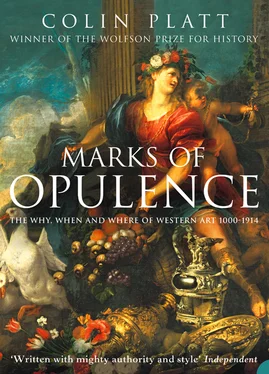‘Death was everywhere’ in post-plague rural Normandy, of which fully half the population had disappeared by 1380. 6 In Castile likewise, in the wake of ‘the Great Death’, settlement desertions gathered pace as bubonic plague returned again in 1363–4, in 1374, in 1380, in 1393–4, in 1399 and 1400. 7 But while Castile shed many villages in the Black Death’s aftermath, Normandy lost rather few. And here it was the weather, rather than plague, that made the difference. The hot dry summers and mild wet winters of temperate Europe’s high-medieval warm epoch had begun to break up shortly after 1250. And what followed was a much lengthier cooling phase, starting with the great sea-storms and coastal inundations of the late thirteenth century and persisting through the rest of the Middle Ages. Characterized by wild temperature swings from cold to hot again, with their associated floods and droughts, it damaged most particularly those outlying farming communities which, in two centuries of increasing overcrowding before the Great Pestilence, had pushed out settlement into the more marginal territories on the hillsides, in the marshlands, and through the forests. Too hostile to allow survival, Castile’s parched and barren uplands were among the first to be deserted, as were the thin-soiled hill-top settlements of Mediterranean Pistoia, and the eroded slopes of Bray in the otherwise lush green pastures of Atlantic Normandy.
Imposed rather than created, plague and a deteriorating climate were the two principal exogenous factors in the Great Recession of the ‘long’ fifteenth century. No Western European economy was unaffected by them. Yet it was the endogenous factors – made by man himself – which were more likely to touch the arts directly. Chief among these was the weakness of money systems: a combination of politically-driven debasements (almost always to finance a war) and of chronic silver shortages in the West. Precisely because such crises were man-made, their incidence and fall-out could differ spectacularly between neighbours. Weak currencies and bullion famines were everywhere the norm in fifteenth-century Europe. But in Spain, whereas Aragon maintained a strong currency, Castile’s was one of the weakest; and while bullion in Aragon was in short supply, Castile’s location on the trade routes north from Africa kept gold flowing through the markets of Seville. 8
For prince and people alike, Philip the Good concluded in 1433, ‘ung des principaulx poins de toutes bonnes policies … es davoir monnoye ferme et durable, tant d’or comme d’argent’. 9 And it is perfectly true that a weak currency – the very reverse of une monnaye ferme et durable – was especially damaging to the receipts of great landowners, dependent on long-term leases and sluggish rents. Inflation, on the other hand, suited rent-payers very well, leaving fifteenth-century governments with the dilemma that if they devalued, the aristocracy rebelled, while every attempt to strengthen the currency was certain to be resisted by their tenants. In the event, it was the nobility who cried loudest, swinging the balance in favour of strong money. And the regular savage debasements which alone had enabled Philip VI of France to pay his troops in the opening campaigns of the Hundred Years War, were already largely over by 1360. For the next 350 years, interrupted only by such short-term wartime debasements as those of 1417–22 and 1427–9, France pursued the strong money policy, supported by taxation, which best suited its tax-exempt nobility. Yet the attractions of a stratagem which – explained Guillaume le Soterel (treasurer general of Navarre) – allowed the prince to ‘strike coin as feeble as he likes to have the means to pay his troops to defend him and his people and his land’, were too powerful to resist in a crisis. 10 And nowhere was this more obvious than in post-Black Death Castile, where four ‘spectacularly awful’ debasements – starting in 1354, 1386, 1429 and 1463 – each paid for a war but cost the maravedi , or Castilian money of account, as much as 95 per cent of its value. 11
In contrast, the post-plague Low Countries under their Burgundian dukes – Philip the Bold (1384–1404), John the Fearless (1404–19), Philip the Good (1419–67) and Charles the Bold (1467–77) – became a model of firm government and strong money. Yet precipitous debasement would return, if only briefly, at the start of Habsburg rule in the 1480s: again to pay for mercenaries. Nor had it been possible for the dukes, vastly wealthy though they were, to survive unscathed through the deeply disruptive bullion famines of the fifteenth century. The accompanying hiatus in Europe’s money supply imposed constraints of every kind on the economy. It had begun with the mid-fourteenth-century exhaustion and closure of the Central European silver mines, aggravated by hoarding and accumulations of plate, and by the steady drain of bullion towards the East. Severe by 1400, the famine was most complete in 1440–65, when so catastrophic were the silver shortages that every mint was empty and hardly a new coin was struck. Surrounded by a countryside in deep recession, mid-century Brussels (home of the Burgundian court) was one of only four Brabantine cities to ride the storm successfully, the others being Malines (the legal centre), Louvain (for its new university), and Antwerp (for its capture of the English cloth trade). Even so, for almost a generation from 1437 the Brabantine mint at Brussels struck no new silver coins, closing completely (i.e. for gold as well as silver) for rather more than half of that long period. 12
Defaulting rulers, among them Edward IV of England, contributed to the crisis which, from the late 1450s, had enveloped even Florence, damaging the Medici and causing the collapse of several major banking families (the Baldesi, the Partini, the Banchi and their like) in the late autumn of 1464. ‘It is the greatest calamity that has happened in this city since 1339 [the bankruptcy of the Bardi and Peruzzi]’, reported Angelo Acciaiuoli, himself a banker, that December. However, Florence’s crisis proved short-lived, and of more general significance to the economies of the West was the all but total disappearance – ‘throughout the universe’, thought the councillors of Barcelona in 1447 – of an official silver coinage, along with the small change (petty currency or ‘black’ money) of everyday transactions in street and marketplace. 13 Disadvantaged already by uncompetitive pricing and by the deflationary pressures of the Burgundians’ pursuit of hard money, the once famous Brabantine draperies, with their long-established German and French outlets, had only just survived the growing competition of English imports. Then, in the mid-fifteenth century, two decades of currency starvation wiped them out. 14
A flexible economy – and Brabantine Malines had one of those – can survive just about anything. But whereas the weavers of Malines moved successfully into dyeing and leather-processing, gun-founding, furriery, embroidery and carpet-making, the more normal case was that of Flemish Ypres, unable to diversify or to make the required transition from the high-cost quality draperies of the traditional Low Countries industry to the cheaper cloths which alone could compete with English imports. There had been some 1500 looms at Ypres in 1311; by 1502, that number had fallen to just a hundred, while population had retreated by two-thirds. 15 Flanders’ loss was England’s gain, with English cloth exports rising by as much as two and a half times between Edward IV’s debasements of 1464–5 and the early 1500s. However, England too had suffered devastating currency shortages in the mid-century. And the subsequent continent-wide success of English cloth – swamping the European markets in what would be likened thirty years later to ‘an immense inundation of the sea’ – was at least in part the product of a 1450s rationalization of the export trade, concentrating capital in fewer hands as those without access either to cash or to credit went out of business. 16
Читать дальше












